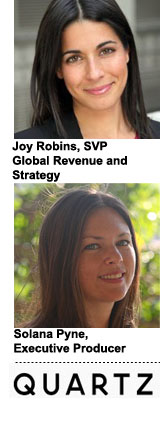
Atlantic Media-owned Quartz is unapologetic about the absence of pre-roll on its properties.
“It’s the reason we don’t support standard ads and why we have control over what runs onsite,” said Joy Robins, SVP of global revenue and strategy for Quartz. “It’s also another reason why we made a conscious decision not to run pre-roll on Quartz.”
Quartz has also steered away from programmatic, opting instead to monetize ads only through direct sales.
“One reason we decided to do everything direct was in service of the user experience,” Robins added.
That strategy has paid off for the publisher’s video operation, said Robins and Solana Pyne, Quartz’s executive video producer.
Despite programmatic’s promise of scale, Quartz achieves reach with an emphasis on video production quality – and by amplifying its direct sales via social distribution, Robins said.
In less than three weeks, one of Quartz’s Facebook Watch programs, “In the Deep,” for instance, was viewed more than 2.6 million times and gained 50,000 subscribers.
Quartz is also launching a documentary video series called “What Happens Next” with Retro Report. AT&T Business sponsored the eight- to 10-minute videos, which will be distributed onsite and via social platforms.
Robins and Pyne spoke with AdExchanger.
AdExchanger: Where is Quartz Video growing?
SOLANA PYNE: When we began, we were a small, three-person lab publishing directly to Facebook because that was a source of lots of traffic for us. It seemed like a natural place to experiment, figure out what is the voice of Quartz Video and get that immediate feedback from our audience. We had some success there with short videos that worked in the news feed, which didn’t prioritize sound.
Then, as we got bigger – we’re now at nine people and an intern – we wanted to build on what we learned about storytelling from Facebook and try these longer-form, mini-documentary series.
Are you finding more payoff with short- or long-form?
PYNE: Everyone we hire can shoot, narrate, edit and report. We think about (video) production much like the newsroom does, which is to say we want our reporters to be thinking about the short and long at the same time, so we don’t have anybody dedicated to a single platform or format.
An intern starting out might focus more on Facebook videos since it’s a good place to get a look and feel for our style, but we encourage our team not to think of themselves only working in one format, but rather what platform suits their story.
The Atlantic shifted its player to YouTube, which is courting more publishers directly. Are you also using YouTube’s player?
PYNE: We initially focused on Facebook and were using a custom player, but ultimately, as we started thinking more about our presence on YouTube, it felt more like a natural thing because we were already posting to so many different platforms from a workflow perspective.
It was easier if we’re just putting video content on YouTube. It helps us grow our audience there and makes it easier to export and upload video directly to Facebook or Twitter.
JOY ROBINS: This [migration to YouTube] was fairly recent for us and part of a broader strategy around YouTube in general.
Where do you predict the most payoff in terms of platform monetization?
ROBINS: We’re definitely excited by the focus Facebook puts on video, but we still look at video from the branded content side as just another format in which to tell stories.
Our answer to brands looking to create content on Facebook is we try to focus on the story, the narrative and if video is even the right vehicle for that. Then, we figure out how to amplify it.
We don’t sell pre-roll. When we had a custom player, we actually created a custom opt-in video experience, but we’ve started to see brands recognizing that pre-roll isn’t the optimal experience.
The reason sell-out is as high as it is on brand-direct platforms is it’s really difficult to drive volume and scale on your owned-and-operated [properties] versus what you can drive via social. It’s why we wanted to follow a distributed model in service of that end user.
How are you expanding your video operation?
ROBINS: We’re always thinking about quality. And as an organization, we always think about both the short and the long. From the beginning, our focus has been on the story itself, and we’re always thinking about new ways to tell the story.
The short answer is we want to keep doing longer-form, but aren’t opposed to the idea that some stories are best told in short-form.
PYNE: Our most recent Facebook Watch show is a narrative documentary about ocean research, and it’s been viewed more than 2.6 million times. It’s interesting because one of our very first viral hits was a short-form video about deep-sea research. I think it shows how, when we continue our storytelling but in different formats, we find success.
This post was syndicated from Ad Exchanger.

More Stories
Daily Wire Welcomes Perplexity to Advertise on The Ben Shapiro Show
Here’s the Roundup for the Week Ending March 7
Aflac’s Dan Amos Reveals How He’s Successfully Held Onto the CEO’s Job for 35 Years